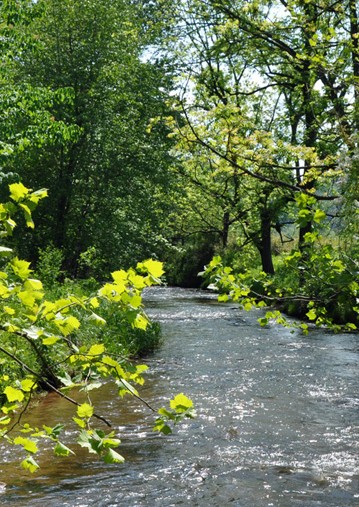From The Franklin Press, April 18, 2014:
 How do you know if a stream isn’t healthy? Do you take its temperature? Check to see if it’s in pain? Or do you simply notice that something isn’t right? Unusual stream flows can indicate a stream is unhealthy. If a stream is not flowing normally, that usually indicates it is unhealthy. Maybe the water is gushing faster than usual. Perhaps where there were once schools of fish there are now none. Changes like this would most likely be evident to anyone who spent a lot of time with the stream. But what if the stream change took place over decades instead of days?
How do you know if a stream isn’t healthy? Do you take its temperature? Check to see if it’s in pain? Or do you simply notice that something isn’t right? Unusual stream flows can indicate a stream is unhealthy. If a stream is not flowing normally, that usually indicates it is unhealthy. Maybe the water is gushing faster than usual. Perhaps where there were once schools of fish there are now none. Changes like this would most likely be evident to anyone who spent a lot of time with the stream. But what if the stream change took place over decades instead of days?
In our last column we learned that what makes a beautiful stream can be different depending on the point of view. For example, a beautiful stream for a fish may not be very attractive to a human. Could the same be true for stream health? Let’s compare a stream to a car for a moment. Most people would probably agree a healthy car would run smoothly. There would be no black smoke spewing out of the tailpipe, no funny noises as it drove down the highway. It would be functioning well. And if the driver had to swerve suddenly around debris, it would be able to return quickly to its position on the road. Healthy streams can be thought of in a similar way.
A healthy stream is a functioning stream. Although the purposes of a stream vary depending on the region, for a majority of streams in the Southern Appalachians a healthy stream means providing habitat for fish and other aquatic animals, moving fresh water from the mountains to the valleys, and carrying nutrient rich sediment to downstream areas. Another way a healthy stream can be identified is by seeing how long it takes the stream to recover after a flood or drought. A healthy stream that is well connected to the entire river system and protected from excessive erosion will be able to return to its normal state much faster than an unhealthy stream.
An unhealthy stream looks different. Although it is relatively easy to notice if a stream changes suddenly, some streams have been unhealthy for so long that no one is really sure what the natural state is. Luckily, there are a set of characteristics that generally define a healthy stream.
A short visual assessment survey specific to southern Appalachian streams (saSVAP) was developed to allow those of us who aren’t stream scientists to determine whether a stream is healthy. The Land Trust for the Little Tennessee (LTLT) has adopted saSVAP and given it a new name: Grade Your Stream. The survey calls for evaluating stream traits, such as the number of bends and pools present within the stream. Both of these are important to consider because fish need pools to survive and the bends in a stream help slow down water flow and reduce erosion.
Another trait examined in this survey is livestock access. Although manure may seem harmless because it’s biodegradable, it’s not normally found in a stream and can upset the natural balance by adding more fertilizer-like substances to the water. When more fertilizer is available, other plants or animals, which are not normally present are sometimes able to take advantage of the new source of food. For example, a clear, fast flowing stream could become clogged with algae as fertilizing products are added, making it difficult for other living things to survive.
In addition to livestock, vegetation along the stream bank is also assessed. A diverse assortment of grasses, shrubs and trees along the stream bank provide a range of services to the stream, most importantly an extensive below ground root system that prevents bank erosion. Larger shrubs and trees have the added bonus of providing shade to the stream. A shaded stream is more likely to provide coveted habitat to various freshwater fish living within Southern Appalachian streams, such as the native brook trout with which we explored streams in last week’s column. In an effort to lower stream temperatures and erosion, LTLT has developed a program called “Shade Your Stream.” A major focus of the program is to make recommendations to land owners as to which vegetation types are the most beneficial to plant along the stream bank.
If you are interested in learning more about what makes a healthy stream or improving the health of a stream on your land, contact Jason Meador, [email protected] or 828-524-2711 ext. 309, at the Land Trust for the Little Tennessee (LTLT) for information on the Shade Your Stream initiative or to participate in the LTLT’s future rollout of “Grade Your Stream.”
This column is produced by members of the Coweeta Listening Project (CLP), a branch of the Coweeta Long Term Ecological Research Program. Views expressed here are not representative of the USDA Forest Service or the Coweeta Hydrologic Lab. Please share questions, comments, or suggestions for future topics at [email protected] or Coweeta Listening Project, UGA, 210 Field St., Room 204, Athens, GA 30602.

